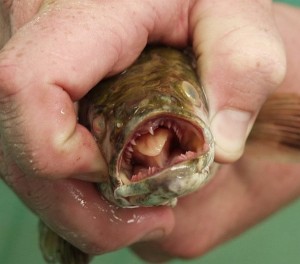By Jon Gaskell
Capital News Service
LANSING— Beware the Northern snakehead. Beware the inland silverside. And beware a host of other invasive species prompting a recent report recommending spending billions to separate the Mississippi River from the Great Lakes.

An angry Northern snakehead. Photo: U.S. Fish and Wildlife Service
The Asian carp is the media darling that gets all the attention. But according to the U.S. Army Corps of Engineers, there are 39 other “high-risk invasive species” that might migrate through Chicago waterways and have the potential to wreak ruin on native ecosystems.
Of these species, 10 could potentially cause huge environmental damage, the agency said.
“Asian carp are sort of the canary in the coal mine,” said Jared Teutsch of the Chicago-based Alliance for the Great Lakes. “They could be the first in, but there are many other threats.”
Among them:
- The Cuban bulrush and marsh dewflower are two aquatic plants that could crowd out other plants and degrade fish habitats. The Cuban bulrush is native to South America and the marsh dewflower comes from Asia. Both have taken root across the southeastern U.S. and could spread to the Great Lakes.
- The inland silverside, a 6-inch fish, has made its way up the Mississippi to northern Illinois and could harm the Great Lakes ecosystem by competing with native species for plankton. The silverside already has significantly damaged fish in California and caused some to go extinct, according to the U.S. Geological Survey.
- The northern snakehead, a predatory, pike-like fish that can grow up to 3 feet long and is known for its ability to breathe on land for up to four days and migrate between bodies of water up to one-quarter mile apart. It has established populations in Maryland, Virginia, Arkansas, Pennsylvania and New York. With a voracious appetite and no natural predators, the snakehead could destroy large populations of native fish and out-compete them for food.
